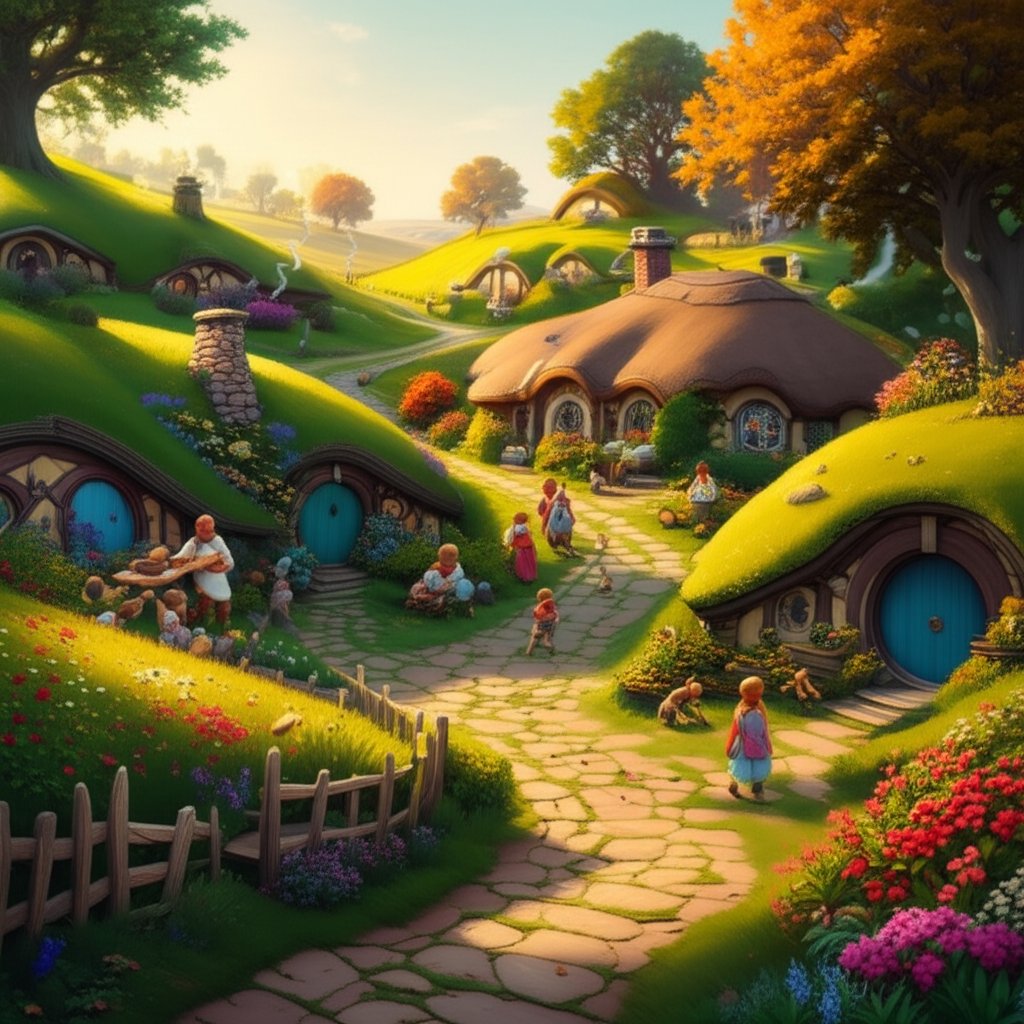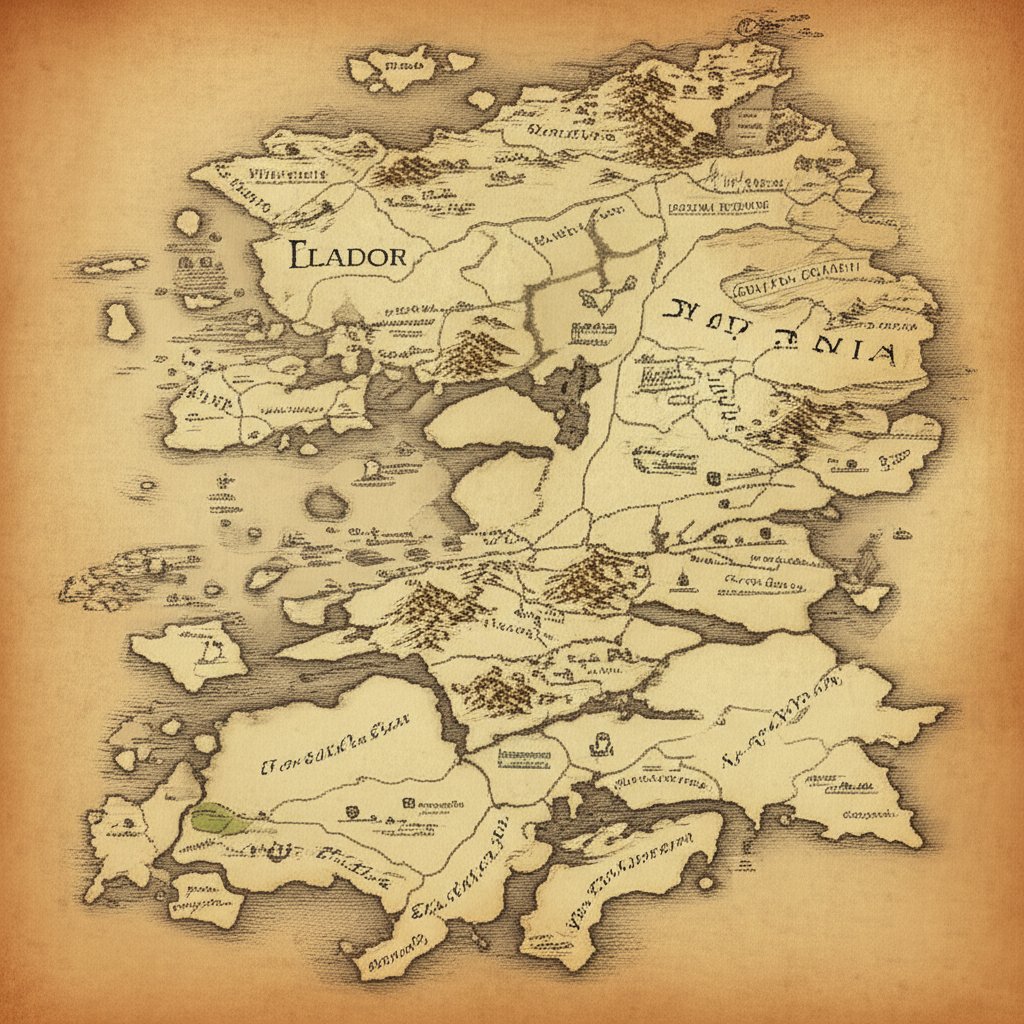Introduction to the Halfling Name Generator
Have you ever sat down to create a halfling character and found yourself stuck at the very first step—choosing the perfect name? Whether you’re a player crafting your next memorable hero or a Game Master building a bustling halfling village, the right name can set the tone for your entire adventure. That’s where a halfling name generator comes in, offering inspiration tailored to the unique spirit of these beloved fantasy folk.
But why do halfling names matter so much? Let’s take a closer look. In tabletop role-playing games (TTRPGs) like Dungeons & Dragons, halflings are more than just pint-sized adventurers. Imagine a character who loves comfort, is quick with a smile, and stands firm when it counts. Halflings are often described as:
- Comfort-loving: They cherish warm hearths, good food, and the safety of community.
- Good-natured: Friendly and welcoming, they’re known for their kindness and easygoing attitude.
- Courageous: Despite their size, halflings routinely surprise others with their bravery and cleverness.
- Community-oriented: Family and tradition are at the heart of halfling culture, with names often reflecting these values.
When you use a halfling name generator, you’re not just picking random syllables. You’re searching for names that echo these characteristics—names that sound as cozy as a fireside tale, yet hint at hidden depths of courage and wit. For example, names like "Roscoe Tealeaf" or "Seraphina Underbough" instantly paint a picture of a character who feels right at home in a storybook village or embarking on an unexpected quest.
Why does this matter? Names are the foundation of character identity. As soon as your group hears a name like "Perrin Greenbottle," they’ll start to imagine that character’s quirks, backstory, and even their favorite pie recipe. A well-chosen name can make a character leap off the page—or the game board—and linger in memory long after the session ends[source].
This guide is designed to be your one-stop resource for all things halfling names. Whether you need a single name for a player character or a whole list for a halfling town, you’ll find tips, examples, and creative strategies here. From understanding the classic halfling archetype to exploring naming conventions and world-building, we’ll help you bring your fantasy world to life—one name at a time.

Finding the Perfect Name for Your Halfling Character
When you sit down to create a new halfling, do you ever wonder—what makes a name truly memorable? Is it the way it rolls off the tongue, its hidden meaning, or how it fits with your character’s story? The art of halfling character creation goes far beyond clicking a button on a random generator. Instead, it’s about weaving personality, culture, and backstory into every syllable.
Why Go Beyond Random Generation?
Sounds complex? It doesn’t have to be. Imagine your halfling’s name as the first chapter in their life story. A name like "Merric Brushgather" might hint at a family of artists—or perhaps a mischievous streak. "Seraphina Underbough" conjures images of grace and a deep connection to nature. The best unique halfling names often reveal:
- Family traditions or professions (like "Tealeaf" or "Greenbottle")
- Personal ambitions or quirks ("Euphemia" suggests cheer; "Perrin" means rock—sturdy and reliable)
- The region or culture your halfling comes from (names inspired by forests, rivers, or even local legends)
In short, a thoughtfully chosen name can instantly tell your group: this character is more than a stereotype—they’re a living, breathing part of your world.
Capturing Essence: Tools and Inspiration
But how do you capture that essence? The best name generators—whether for halflings or any culture—do more than jumble sounds. They reflect heritage, emotion, and context. For example, if you’re seeking inspiration outside the usual fantasy tropes, specialized tools like the Chinese Name Generator offer a fresh approach. These tools don’t just create random names; they focus on meaning, phonetic beauty, and cultural resonance. You might discover a name that means "bravery" or "forest," sparking ideas for a halfling who is both courageous and deeply tied to woodland lore.
Writers and gamers often adapt such names, blending their unique sounds or meanings into halfling culture. This creative cross-pollination helps you avoid clichés and ensures your halfling stands out in any campaign or story.
Checklist: How to Finalize a Halfling Name
Still not sure if you’ve found the right fit? Ask yourself these questions before settling on a name:
| Question | Purpose |
|---|---|
| Does the name reflect my character’s personality or backstory? | Ensures the name matches the character’s role and history. |
| Is it easy to pronounce and remember? | Keeps gameplay smooth and the character memorable. |
| Does it fit with the setting’s culture or geography? | Maintains consistency within your fantasy world. |
| Are there hidden meanings or puns that add depth? | Adds layers for players to discover over time. |
| Could this name inspire future storylines or character development? | Opens doors for growth and intrigue. |
Remember, the most unique halfling names aren’t just clever—they’re meaningful. By blending inspiration from name generators (including culturally rich ones like the Chinese Name Generator) with a little personal creativity, you’ll create halflings who feel real, memorable, and ready for adventure.
Next, let’s break down the building blocks of halfling names—first and last—so you can mix, match, and invent with confidence.
Breaking Down Halfling First and Last Names
When you start looking for the perfect halfling name, you might wonder: What actually makes a name sound distinctly “halfling”? Is there a formula, or do you just trust your instincts? Let’s break down the halfling name structure—from first names to surnames—so you can confidently craft names that feel right at home in any fantasy village or bustling halfling market.
What Makes a Halfling Name Sound Right?
Imagine meeting a character called "Rosie Greenbottle" or "Drogo Underfoot." Instantly, you know they belong in a world where comfort, nature, and family matter. That’s no accident. Halfling names are carefully built using patterns that echo their culture and values. Here’s how it works:
- First names are often short, melodic, and easy to say—think "Pip," "Milo," "Lily," or "Euphemia." They frequently use soft consonants and gentle vowels, making them sound friendly and approachable.
- Last names (or surnames) are more than just labels. They tell a story—about a profession, a favorite landscape, an ancestor, or even a quirky family trait.
But what themes do these names draw on, and how do you combine them for maximum effect?
First Names: Melodic, Nature-Inspired, and Meaningful
Halfling first names tend to be:
- Short and sweet: Names like "Pip," "Milo," or "Ros" are easy to remember and say.
- Melodic: Especially for female characters, names often have a gentle, lilting quality—"Seraphina," "Amaryllis," or "Eglantine."
- Nature-inspired: Many names evoke plants, flowers, or natural beauty, such as "Willow," "Daisy," or "Thistle."
- Diminutives and affectionate forms: Endings like "-y," "-ie," or "-o" ("Merry," "Rosie," "Bilbo") add warmth and familiarity.
Family Names: Professions, Places, and Playful Quirks
When it comes to halfling surname ideas, the options are almost endless. Surnames often reflect:
- Professions or skills: "Brushgather," "Tealeaf," "Miller," or "Cooper." These hint at what the family is known for in the community.
- Natural features: "Underhill," "Greenbottle," "Meadowbrook," or "Riversong." These evoke the halflings’ love of the land.
- Notable ancestors or traits: "Proudfoot," "Brandybuck," or "Lightfoot"—names that may honor a founder or describe a family reputation.
- Quirky or whimsical elements: Sometimes, surnames are just fun—"Smallburrow," "Goodbarrel," or "Longbottom." They often combine two familiar words for a playful effect.
Some halfling names also use prefixes and suffixes to create a sense of tradition and belonging. For example, prefixes like "Alba-" or "Bramble-" and suffixes like "-wise," "-foot," or "-berry" can be mixed and matched for endless combinations.
Comparison Table: Building Blocks of Halfling Names
| Name Component | Examples | Associated Meaning |
|---|---|---|
| First Name (Short, Melodic) | Pip, Milo, Lily, Rosie, Merry | Approachability, warmth, friendliness |
| First Name (Nature-Inspired) | Willow, Daisy, Thistle, Amaryllis | Connection to nature, beauty, growth |
| Surname (Profession-Based) | Brushgather, Miller, Cooper, Tealeaf | Family trade, skill, or local reputation |
| Surname (Natural Feature) | Underhill, Greenbottle, Meadowbrook, Riversong | Geography, home, or environmental ties |
| Surname (Ancestral/Quirky) | Proudfoot, Brandybuck, Lightfoot, Goodbarrel | Heritage, family trait, or playful spirit |
| Prefix + Suffix | Albafoot, Brambleberry, Roswise, Willawood | Tradition, creativity, and cultural resonance |
Tips for Combining First and Last Names
- Mix a melodic first name with a nature-based surname for classic halfling charm (e.g., "Lily Underhill").
- Pair a short, punchy first name with a quirky or profession-based surname for a memorable adventurer (e.g., "Pip Brushgather").
- Use prefixes and suffixes to invent something new, while still keeping the halfling feel (e.g., "Fennberry" or "Willafoot").
By understanding these patterns, you’ll find it easier to use a halfling name generator or invent your own names that fit seamlessly into any fantasy world. Next, we’ll explore how these patterns shift when naming female halflings—and how to find names that feel both traditional and fresh.
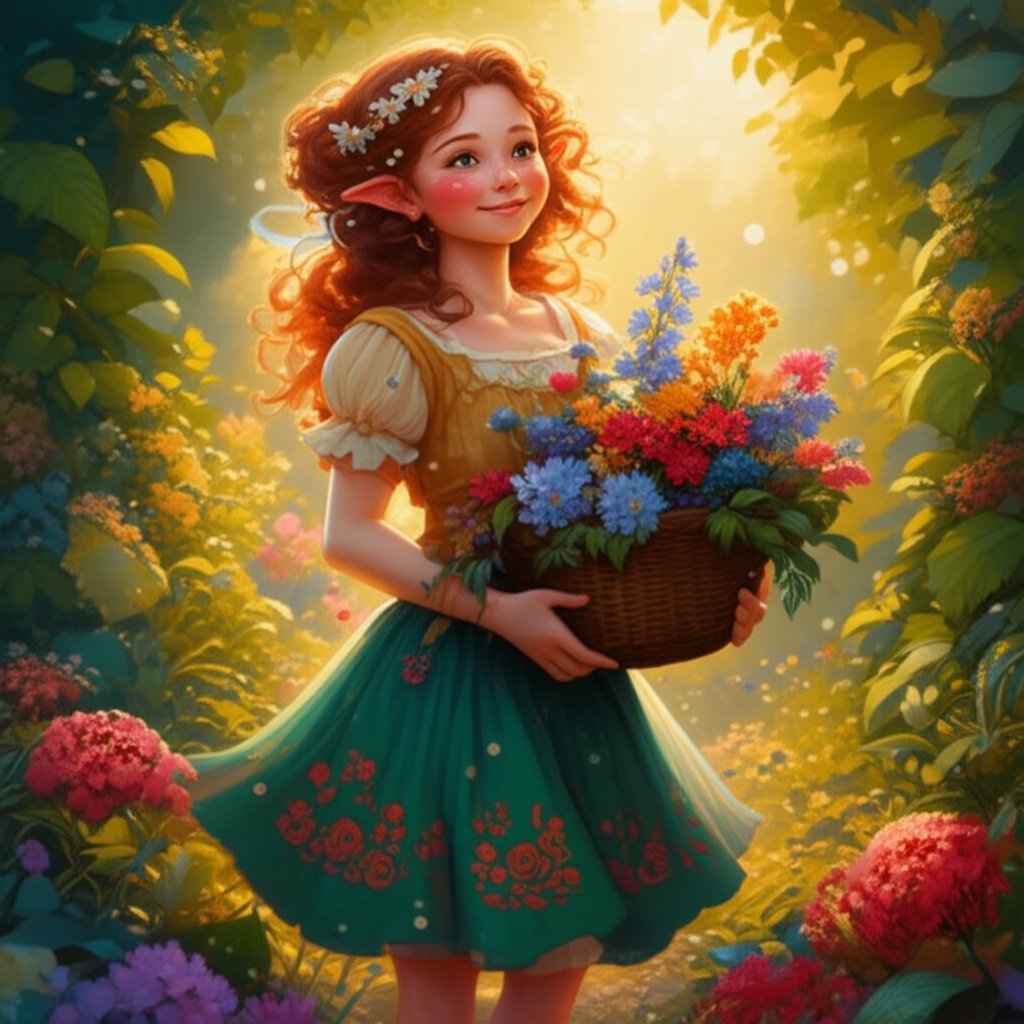
Exploring Traditional Female Halfling Names
When you picture a halfling heroine, what kind of name springs to mind? Is it something light and melodic, or perhaps a name echoing the beauty of nature? If you’ve ever used a female halfling name generator, you’ll notice a delightful pattern: these names often draw from the natural world, precious stones, and the warmth of a welcoming home. Let’s break down what makes halfling names female so distinctive and how you can choose one that fits your character perfectly.
What Defines a Classic Female Halfling Name?
Sounds complex? It’s actually simple once you know what to look for. Most traditional female halfling names share a few key aesthetics:
- Floral and Botanical: Many names are inspired by flowers, herbs, and plants—reflecting the halflings’ love of gardens and the outdoors.
- Gemstone and Virtue: Names that sparkle with the charm of jewels or embody positive qualities, like kindness or joy.
- Cheerful and Warm: Names that feel friendly, inviting, and full of life—often with soft sounds and gentle rhythms.
Imagine a halfling matriarch named "Marigold Goodbarrel" or a young adventurer called "Ruby Tealeaf." These names instantly evoke images of vibrant villages and cozy gatherings around a hearth.
Floral & Botanical Female Halfling Names
Looking for a name that feels rooted in nature? Here are some beautiful options, inspired by classic sources:
- Daisy
- Lily
- Rose
- Pansy
- Marigold
- Camellia
- Mimosa
- Primula
- Peony
- Amaryllis
- Myrtle
- Violet
Pair any of these with a nature-themed surname—like "Hilltopple" or "Greenbottle"—for a name that feels right at home in a halfling village.
Gem & Virtue Female Halfling Names
If you want a name that shines with inner or outer beauty, consider these gemstone-inspired and virtue-based names:
- Crystal
- Diamond
- Pearl
- Ruby
- Seraphina
- Esmerelda
- Elanor
- Belba
- Prisca
Names like "Pearl Goodbody" or "Seraphina Underbough" blend elegance with the wholesome charm that halflings are known for.
Classic & Cheerful Female Halfling Names
Sometimes, the best names are the ones that sound like a smile. These names are melodic, friendly, and often have a cozy, familiar feel:
- Euphemia
- Donamira
- Mirabella
- Lobelia
- Hilda
- Dora
- Jillian
- Susannah
- Melindy
- Lavinia
Try matching "Mirabella" with a quirky surname like "Brushgather" or "Tighfield" for that extra touch of halfling personality.
Tips for Choosing the Right Female Halfling Name
- Mix and match first names and surnames from different categories for a unique result.
- Say the name aloud—does it sound melodic and friendly?
- Consider your character’s background: a gardener might suit "Daisy," while a jeweler could go by "Ruby."
- Look for names that feel warm and inviting, just like halfling communities themselves.
By drawing on these themes, you can use a female halfling name generator or craft your own combinations that capture the heart of halfling culture. Next, we’ll show you how to tailor halfling names to fit different adventuring classes, from rogues to bards—so your character’s name tells their story before they ever roll the dice.
Naming Your Halfling Rogue and Other Classes
When you picture your halfling swinging from a tavern chandelier or quietly picking a lock, have you ever wondered—does their name fit their daring deeds? The right name doesn’t just sound good; it signals your character’s class, skills, and even their reputation. Let’s explore how you can use a halfling rogue name generator or your own creativity to craft names that perfectly suit rogues, fighters, bards, and beyond.
Why Class Matters in Halfling Names
Sounds complex? It’s easier than you think. In fantasy worlds, names often hint at a character’s profession or role. For halflings, this is especially true—whether you’re a nimble rogue, a bold fighter, or a whimsical bard, your name can shape first impressions. Imagine meeting two halflings: one called "Tuck Quickstep" and another named "Bramble Ironroot." Instantly, you sense that Tuck is swift and sly, while Bramble might be sturdy and dependable.
Halfling Rogue Names: Short, Sharp, and Subtle
Rogues thrive on agility and wit, so their names often reflect that. If you’re using a halfling rogue name generator, look for names that are quick to say and easy to remember. Here are some key traits and ideas for rogue names:
- Short and punchy: Names like "Pip," "Finn," or "Nim" are quick, just like their owners.
- Playful or sly surnames: Surnames such as "Quickstep," "Shadowpocket," or "Fleetfoot" suggest stealth and speed.
- Subtle puns or wordplay: Halfling rogues love names with hidden meanings—"Slip Underleaf" or "Flick Goodbarrel" hint at their sneaky talents.
Need inspiration? Try mixing and matching from the lists below:
- Pip Quickstep
- Nim Shadowpocket
- Tara Fleetfoot
- Finn Underleaf
- Jinx Brushgather
- Merry Flicker
Fighter and Barbarian Halfling Names: Sturdy and Strong
Fighters and barbarians often favor names that sound solid and dependable. These halfling class names might be a bit longer or have a strong, earthy feel. Consider these approaches:
- Sturdy first names: "Bramble," "Hob," or "Rufus" evoke strength.
- Grounded surnames: "Ironroot," "Stonehill," or "Oakbarrel" suggest resilience.
- Names with weight: "Milo Strongarm" or "Hob Oakbarrel" communicate a fighter’s presence.
Sample combinations for inspiration:
- Bramble Ironroot
- Hob Stonehill
- Milo Strongarm
- Rufus Oakbarrel
- Dora Goodbarrel
Bard and Wizard Halfling Names: Whimsical and Clever
Bards and wizards bring a touch of magic and creativity to their names. These halflings often choose melodic or whimsical names—sometimes with a hint of mystery or artistry.
- Melodic first names: "Lira," "Euphemia," or "Peregrin" sound musical or poetic.
- Whimsical surnames: "Songbrook," "Starglow," or "Lightfoot" evoke imagination.
- Names with flair: "Lira Songbrook" or "Peregrin Starglow" stand out in any tavern or wizard’s tower.
Try these combinations for your bard or wizard:
- Lira Songbrook
- Euphemia Lightfoot
- Peregrin Starglow
- Merry Willowisp
- Seraphina Goodbody
Tips for Class-Driven Halfling Names
- Say the name aloud—does it match your character’s energy and class?
- Pair a short, sly first name with a stealthy surname for rogues; use sturdy or earthy themes for fighters; go for lyrical or magical touches for bards and wizards.
- Don’t be afraid to invent new combinations or tweak traditional names to better fit your story.
- Keep a list of your favorites—variation helps avoid confusion and keeps your world feeling fresh[source].
By tailoring your halfling’s name to their class, you instantly add depth and personality—making each introduction at the gaming table or in your story more memorable. Next, let’s see how these naming traditions adapt to official D&D 5e lore and subraces, giving you even more ways to personalize your halfling heroes.
Generating Halfling Names for D&D 5e Campaigns
When you’re building a halfling for your next Dungeons & Dragons adventure, you might ask yourself: What makes a halfling name truly feel like it belongs in the world of D&D 5e? Is there a difference between the names you find in the core rulebooks and those you invent yourself? Let’s break down the official lore, explore the nuances between first names, family names, and nicknames, and see how subraces like Lightfoot and Stout shape the art of naming in D&D 5e.
Official Halfling Naming Lore in D&D 5e
According to the Player’s Handbook and supported by official sources, halflings in D&D 5e typically carry three types of names:
- Given Name (First Name): This is the personal name given at birth, often short, friendly, and easy to say. Examples include "Milo," "Lavinia," "Roscoe," and "Seraphina." These names are melodic and approachable, reflecting the halflings’ affable and cheerful nature[source].
- Family Name (Surname): Surnames are often derived from nicknames that became so ingrained they were passed down through generations. They usually hint at a family’s trade, a notable ancestor, or a natural feature—think "Goodbarrel," "Brushgather," or "Underbough." These names ground your character in a wider halfling community and tradition.
- Nickname: Sometimes, halflings are given a nickname by their neighbors or friends. While not all halflings love this tradition, it’s common for a nickname to stick so well it becomes an unofficial second surname. Nicknames often reflect a personal trait, memorable deed, or even a running joke.
By using all three, you can give your character a name like "Milo Goodbarrel, called Pip," instantly painting a picture of personality and heritage.
Lightfoot vs. Stout: How Subraces Influence Halfling Names
When using a dnd 5e halfling name generator, you’ll notice that the two main halfling subraces—Lightfoot and Stout—bring their own cultural influences to naming conventions. Here’s how:
| Subrace | Naming Tendencies | Example Names |
|---|---|---|
| Lightfoot |
| Andry, Bree, Finnan, Merric, Seraphina, Wellby |
| Stout |
| Hob, Milo, Lyle, Portia, Strongheart, Hilltopple |
Lightfoot halflings, the most common subrace, are known for their wanderlust and adaptability. Their names often blend easily into human or elven communities, making them feel at home wherever they go. Stout halflings, sometimes called stronghearts, are more rooted in tradition and tend to choose names that honor their hardy, practical nature—sometimes even with a dwarven flavor.
Tips for Crafting D&D 5e Halfling Names
- Combine a melodic or sturdy first name with a meaningful surname to reflect your character’s subrace and personality.
- Consider adding a nickname if you want to highlight a unique trait or backstory.
- Look for inspiration in the official name lists, but don’t be afraid to invent new combinations that fit your campaign’s setting.
- Say the full name aloud—does it sound like someone you’d meet in a cozy shire or bustling city?
By following these traditions and drawing on both lore and creativity, your halfling’s name will feel right at home in any halfling names dnd campaign. Next, let’s see how naming conventions shift across other popular fantasy RPGs, like Pathfinder and Warhammer, and how you can adapt your approach for different worlds and play styles.
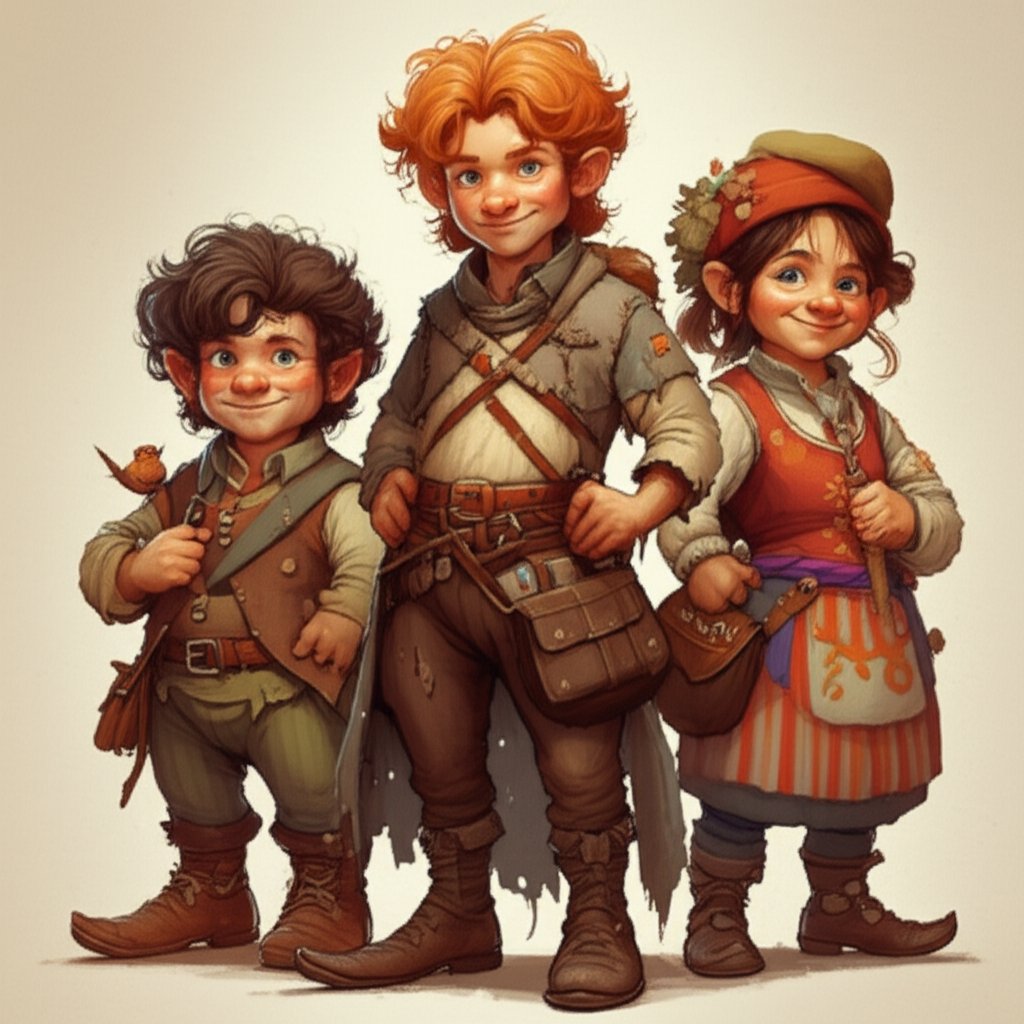
Halfling Naming Conventions in Pathfinder and Warhammer
When you generate a halfling name, do you ever pause and wonder—would this name fit in every fantasy world? Whether you’re using a Pathfinder halfling name generator or seeking inspiration for Warhammer, you’ll notice that each setting puts its own spin on halfling culture and naming traditions. Let’s explore how these worlds shape the names (and personalities) of their halflings, and see how you can tailor your choices to fit the right vibe.
How Halflings Differ Across Fantasy Settings
Sounds complex? It’s actually fascinating once you break it down. Halflings are a staple of tabletop RPGs, but their portrayal—and the names they use—can vary wildly from one game to the next. Here’s what you’ll notice:
- D&D 5e: Halflings here are comfort-loving, optimistic, and deeply rooted in community—think of the classic shire-dweller. Names are melodic, friendly, and often reference nature or professions.
- Pathfinder: Halflings are cheerful, adaptable, and wanderlust-driven. They often blend seamlessly into other cultures, and their names reflect humility and gentleness, avoiding anything that sounds arrogant or ostentatious[source].
- Warhammer: Halflings in the Old World are earthy, practical, and obsessed with food and family. Their names often reflect culinary themes, large families, or rural life, and can be downright whimsical or tongue-in-cheek.
Comparing Naming Patterns: What Makes Each Setting Unique?
Let’s break down the differences using a simple table. This will help you spot the unique flavors each system brings to halfling names and guide you whether you’re using a Pathfinder halfling name generator or a Warhammer halfling name generator for your next character.
| Setting | Halfling Portrayal | Naming Patterns | Sample Names |
|---|---|---|---|
| D&D 5e | Cheerful, community-focused, comfort-loving |
| Seraphina Underbough, Milo Goodbarrel, Roscoe Tealeaf |
| Pathfinder | Optimistic, adaptable, wanderers among other cultures |
| Anafa, Bellis, Jamir, Marra, Sistra |
| Warhammer | Earthy, food-obsessed, large families, rural humor |
| Trudy Talltree, Hisme Stoutheart, Crumleywort, Goodbody, Brambleberry Piecrust |
Practical Examples and Tips for Each System
- D&D 5e: When you want a name that feels classic and warm, pick melodic first names and surnames with nature or profession themes. Try “Lavinia Hilltopple” or “Perrin Brushgather.”
- Pathfinder: Focus on names that are gentle and blend in with neighboring cultures. Avoid anything too flashy. “Etune” or “Yamyra” fit perfectly for a humble, adaptable halfling.
- Warhammer: Let your imagination run wild with food-inspired or tongue-in-cheek surnames. “Piecrust,” “Goodbody,” or “Stoutheart” add instant flavor. Don’t be afraid to get a little silly—after all, in the Mootland, a good joke is as valuable as a good meal[source].
Key Takeaways for Name Generators
- Always match the name style to the world you’re playing in—what works in Pathfinder may feel out of place in Warhammer, and vice versa.
- Consider the cultural and personality traits of halflings in each setting. Is your character a wandering optimist, a practical farmer, or a shire-dweller with a love for comfort?
- Use the sample names and patterns above as templates when using any halfling name generator, or mix and match to invent your own.
Next, we’ll shift our focus from individual names to the world around them—discovering how to name halfling towns and villages in ways that feel just as authentic and memorable.
Creating Authentic Halfling Town and Village Names
When you’re designing a halfling settlement, have you ever stopped to wonder—what makes a village name feel truly "halfling"? Is it the coziness of the syllables, the hint of rolling hills and warm kitchens, or the echoes of laughter drifting from a bustling market square? For Game Masters and world-builders, picking the right halfling village names is just as important as naming your characters. The right name can transport players straight into the heart of a community, setting the stage for memorable adventures.
What Makes a Halfling Town Name Feel Right?
Sounds complex? It’s easier than you think if you focus on the themes that define halfling culture. Most halfling settlements are built around comfort, community, and the bounty of the land. Their names often reflect:
- Geography: Names that reference hills, rivers, meadows, or forests create a sense of place and belonging.
- Agriculture: Villages named after crops, orchards, or farms highlight the halflings’ love of good food and hard work.
- Comfort & Community: Words that evoke warmth, safety, and togetherness—like "Haven," "Hall," or "Home"—instantly signal a welcoming environment.
- Quirky Traditions: Sometimes, a village name reflects a local legend, a founder’s nickname, or even a running joke.
Imagine your players arriving at "Butterpond," "Merryhall," or "Fiddlegreen"—each name paints a vivid picture and invites curiosity about the stories behind it. You’ll notice that many classic fantasy village names follow these patterns, offering a blend of the familiar and the whimsical.
Practical Steps: Generating Halfling Town and Village Names
When you use a halfling city name generator or craft your own, try these simple steps inspired by world-building experts:
- List out the key features of your settlement: Is it near a river? Surrounded by orchards? Known for a legendary pie contest?
- Pick words that evoke those features—"Brook," "Orchard," "Pie," "Hill," "Willow," etc.
- Mix and match with comforting or communal terms: "Haven," "Hall," "Rest," "End," "Green," "Meadow."
- Consider playful or quirky combinations for extra charm—like "Sweetmount," "Starrynight," or "Wishleaf."
- Check pronunciation and flow: Say the name aloud to ensure it’s easy and inviting, not awkward or harsh.
| Theme | Example Names | Implied Atmosphere |
|---|---|---|
| Geography | Butterpond, Hillcrest, Ashbourne, Windrest | Natural beauty, rootedness |
| Agriculture/Food | Meadhaven, Cornhenge, Boarsrest, Sweetmount | Bounty, hospitality |
| Comfort/Community | Merryhall, Goodminton, Winter’s End | Warmth, safety, celebration |
| Quirky/Legend | Fiddlegreen, Wishleaf, Starrynight | Whimsy, local lore |
Beyond Fantasy: Authentic Naming Across Cultures
Ever thought about how naming a halfling town is a lot like crafting an online persona? Just as a village name shapes the story of a community, a culturally authentic name helps content creators and gamers connect with audiences around the world. If you’re looking to break away from the usual fantasy tropes, consider drawing inspiration from real-world languages and naming conventions. Tools like the Chinese Name Generator are designed for cultural depth and authenticity, offering unique sounds and meaningful translations that can spark fresh ideas for both settlements and characters.
Whether you’re building a halfling shire or developing a global online presence, the key is authenticity—names that feel rooted, welcoming, and alive with story. Next, we’ll explore how halfling nicknames add even more flavor and depth to your world, giving every character and settlement a touch of personality that lingers in the imagination.
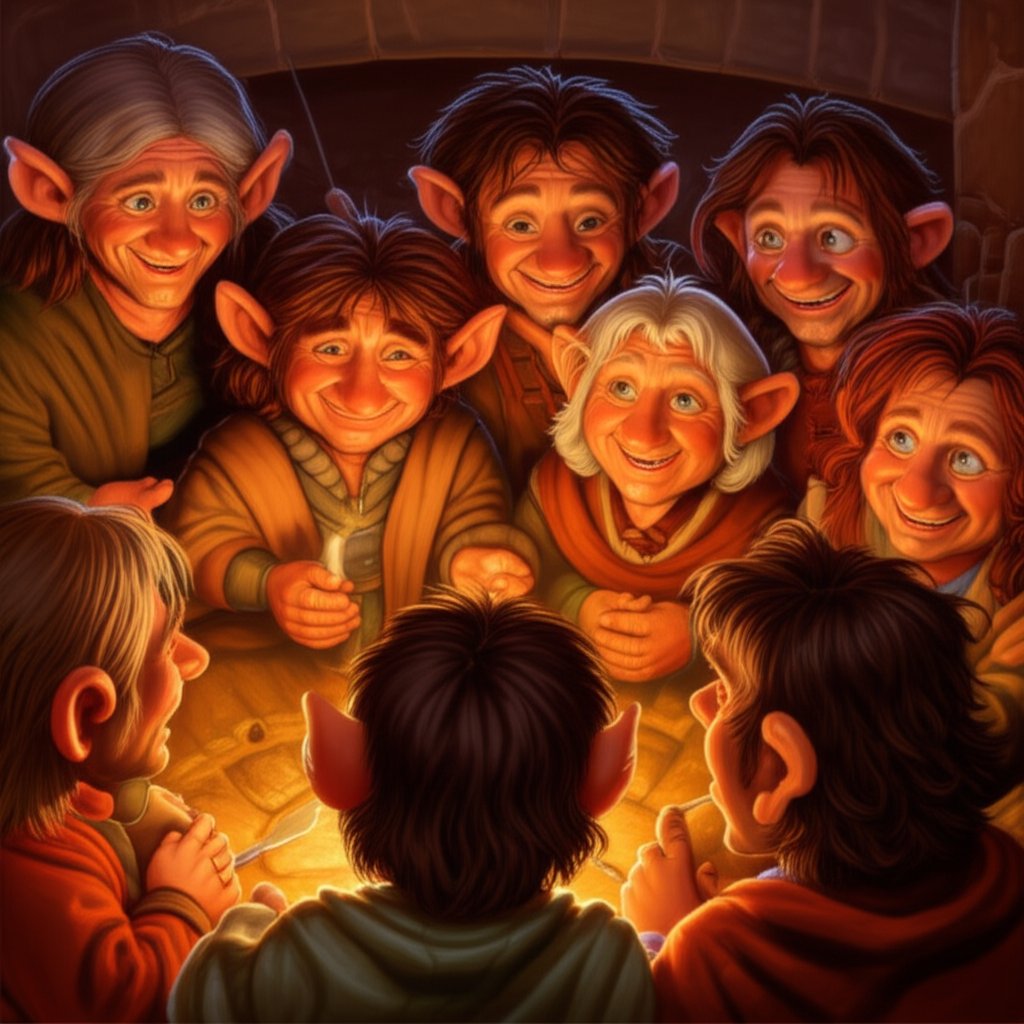
Adding Flavor with Traditional Halfling Nicknames
When you hear a halfling introduce themselves as "Milo Slyhand" or "Jenny Stoutleaf," do you ever wonder—how did they earn that extra name? In halfling culture, halfling nicknames are more than just clever add-ons. They’re living badges of honor, mischief, or affection, each with a story to tell. Let’s explore how nicknames are woven into halfling life, what they reveal about a character, and how you can use them to bring extra depth and humor to your fantasy world.
How Are Halfling Nicknames Earned?
Sounds complex? It’s actually a simple, organic tradition. In most halfling communities, nicknames aren’t chosen at birth—they’re earned through notable deeds, memorable quirks, or even a single unforgettable mishap. Sometimes a nickname sticks after a heroic act; other times, it’s a gentle tease that becomes a term of endearment. Over time, these names can overshadow even family surnames, especially when a halfling’s reputation precedes them.
- Event-Based: A halfling who saves a neighbor from a burning barn might become "Ambercloak."
- Personality Traits: Someone who’s always cracking jokes could be called "Laughingstick."
- Physical Features: A halfling with especially curly hair might earn "Curlytop."
- Occupational Feats: The fastest courier in town could be "Swiftfoot."
- Comedic Mishaps: Did someone trip over six barrels at the harvest festival? "Barreljumper" might follow them for life.
What Do Halfling Nicknames Reveal?
Halfling nicknames serve as a window into a character’s history, personality, and social standing. They’re often used in place of formal surnames among friends and family, signaling trust, affection, or community memory. In some cases, a nickname can even become a mark of prestige or notoriety—especially if it hints at a legendary adventure or a notorious prank.
- "Nimblefingers" – Once picked the mayor’s pocket (to return a lost key, of course), and the town never forgot.
- "Shadowfoot" – Known for sneaking out after curfew and returning with wild stories.
- "Talltalker" – Loves spinning tall tales at the inn, even if nobody believes a word.
- "Fatbottom" – Proud winner of the annual pie-eating contest three years running.
- "Rainrunner" – Famous for delivering a message through the worst storm in decades.
- "Mooncheek" – Always caught daydreaming under the stars, inspiring local poets.
- "Quickwit" – Outwitted a band of goblins with nothing but puns and a loaf of bread.
- "Stickybun" – Earned after an unfortunate incident with a tray of pastries and a very persistent dog.
Funny Halfling Names: Humor and Heart
One of the joys of funny halfling names is their ability to bring a smile to the table. Halflings embrace humor, and their nicknames often reflect this spirit. Whether it’s a gentle tease or a badge of pride, these names keep the mood light and the stories memorable.
- "Butterfingers" – Never met a plate they couldn’t drop.
- "Sleepyhead" – Famous for napping anywhere, anytime.
- "Bumblefoot" – Known for clumsy dancing at every festival.
- "Piecrust" – The village baker who’s always covered in flour.
- "Goosechaser" – Earned after a wild chase through the market square.
Each nickname is a story waiting to be told—a detail that makes your halfling more than just a name on a page. They become a living part of the world, with legends, laughter, and a legacy all their own.
Tips for Creating and Using Halfling Nicknames
- Think about what your character is most famous (or infamous) for—nicknames often follow reputation.
- Mix and match prefixes and suffixes for endless combinations ("Swiftfoot," "Shadowcloak," "Tallfellow").
- Use nicknames to hint at backstory or spark roleplay—let others discover the story behind the name.
- Don’t be afraid to get a little silly—humor is at the heart of halfling culture.
By weaving halfling nicknames into your game or story, you add flavor, depth, and a touch of whimsy that brings every character to life. Next, we’ll wrap up our journey by exploring how a well-chosen name—be it formal, familial, or earned—can be the key to unforgettable halfling stories and worlds.
Conclusion
When you think back on your favorite fantasy adventures, what’s the first detail that sticks with you? Often, it’s the name—a single word that instantly conjures a personality, a backstory, and a world of possibility. That’s why choosing the right name is the cornerstone of every halfling story, whether you’re a player, a Game Master, or an author seeking halfling name inspiration.
Why the Right Name Matters
Sounds simple? Yet, as you’ve seen throughout this guide, a halfling’s name is much more than a label. It’s the first step in storytelling, the spark that ignites curiosity and connection. A well-chosen name—be it "Seraphina Underbough" or "Finn Quickstep"—instantly paints a picture of culture, personality, and adventure. Names ground characters in their world, signal their values, and invite others to imagine the tales they might tell.
- Names reflect a character’s heritage and ambitions.
- They help readers and players remember and relate to your halfling.
- They set the mood—cozy, mischievous, bold, or whimsical—before a single dice is rolled.
Tools and Tips: From Classic to Culturally Rich Fantasy Name Generators
Wondering where to start? Today’s fantasy name generator tools offer inspiration for every kind of creator. You’ll find:
- Game-specific generators for D&D, Pathfinder, Warhammer, and more—each reflecting the unique culture and naming conventions of their worlds.
- General fantasy name generators, which let you mix, match, and experiment with sounds and meanings.
- Culturally focused tools like the Chinese Name Generator from oldwesthistory.net, which provide authentic, meaning-rich names that can break you out of creative ruts and inspire new directions for your halfling’s story.
Imagine adapting a name with the meaning “forest” or “bravery” from a different culture—suddenly, your halfling isn’t just another face in the crowd, but a character with a name that resonates on multiple levels. These tools help you move beyond the ordinary and create names that are as unique as your imagination.
Next Steps: Create, Play, and Inspire
Ready to bring your halfling character—or even a whole village—to life? Here’s a quick checklist to guide your next steps:
| Step | Action |
|---|---|
| 1. Reflect | Think about your character’s story, class, and personality. |
| 2. Explore | Use a mix of name generators (game-based, general, and culturally rich) for inspiration. |
| 3. Personalize | Mix and match elements—first names, surnames, and nicknames—to create something truly yours. |
| 4. Test | Say the name aloud. Does it fit your world and character? |
| 5. Share | Introduce your new halfling to your group, and watch as their story unfolds. |
Remember, every great halfling tale begins with a name full of heart, humor, and hidden meaning. Don’t be afraid to experiment with new tools and ideas—sometimes the most unforgettable characters come from the most unexpected sources. If you’re ever stuck, turn to resources like the Chinese Name Generator for fresh perspectives and culturally rich inspiration.
So go ahead—craft your next halfling hero, name a thriving village, or spin a new legend. With the right name, you’re already halfway to a story your players and readers will never forget.
Frequently Asked Questions about Halfling Name Generators
1. How do halfling name generators work?
Halfling name generators use curated lists of first names, surnames, and cultural patterns inspired by fantasy settings. They combine these elements to produce names that capture the warmth, community, and adventurous spirit typical of halflings. Advanced tools may offer options for gender, class, or setting, ensuring names align with your character’s background.
2. What makes a good halfling name?
A good halfling name is melodic, easy to pronounce, and reflects the character’s personality or family heritage. Names often draw from nature, professions, or playful traits. Combining a meaningful first name with a story-rich surname creates a name that fits seamlessly into fantasy worlds.
3. Can I use halfling name generators for different fantasy games?
Yes, most halfling name generators are versatile enough for various games like D&D, Pathfinder, and Warhammer. However, each setting has unique naming conventions, so it’s helpful to adapt names to match the world’s tone or use specialized generators for each system.
4. How can I create unique halfling names that stand out?
To create unique halfling names, blend elements from different cultures, use meaningful word roots, or adapt names from tools like the Chinese Name Generator. This approach helps you avoid clichés and ensures your character’s name is both original and rich in backstory.
5. Are there tools for generating culturally inspired halfling names?
Yes, tools like the Chinese Name Generator from oldwesthistory.net offer culturally authentic names with deep meanings. These can inspire fresh phonetic and semantic ideas for halfling characters, helping you craft names that break away from standard fantasy tropes.
